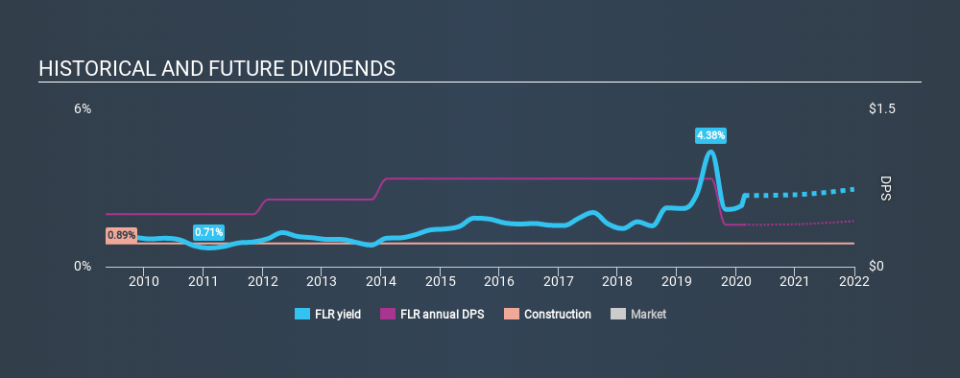Don't Buy Fluor Corporation (NYSE:FLR) For Its Next Dividend Without Doing These Checks

Fluor Corporation (NYSE:FLR) is about to trade ex-dividend in the next 4 days. You will need to purchase shares before the 28th of February to receive the dividend, which will be paid on the 2nd of April.
Fluor's next dividend payment will be US$0.10 per share, on the back of last year when the company paid a total of US$0.40 to shareholders. Calculating the last year's worth of payments shows that Fluor has a trailing yield of 2.7% on the current share price of $14.74. Dividends are a major contributor to investment returns for long term holders, but only if the dividend continues to be paid. We need to see whether the dividend is covered by earnings and if it's growing.
View our latest analysis for Fluor
Dividends are typically paid out of company income, so if a company pays out more than it earned, its dividend is usually at a higher risk of being cut. Fluor's dividend is not well covered by earnings, as the company lost money last year. This is not a sustainable state of affairs, so it would be worth investigating if earnings are expected to recover. Considering the lack of profitability, we also need to check if the company generated enough cash flow to cover the dividend payment. If cash earnings don't cover the dividend, the company would have to pay dividends out of cash in the bank, or by borrowing money, neither of which is long-term sustainable. Over the last year, it paid out dividends equivalent to 311% of what it generated in free cash flow, a disturbingly high percentage. Our definition of free cash flow excludes cash generated from asset sales, so since Fluor is paying out such a high percentage of its cash flow, it might be worth seeing if it sold assets or had similar events that might have led to such a high dividend payment.
Click here to see the company's payout ratio, plus analyst estimates of its future dividends.
Have Earnings And Dividends Been Growing?
Companies with falling earnings are riskier for dividend shareholders. If business enters a downturn and the dividend is cut, the company could see its value fall precipitously. Fluor reported a loss last year, and the general trend suggests its earnings have also been declining in recent years, making us wonder if the dividend is at risk.
The main way most investors will assess a company's dividend prospects is by checking the historical rate of dividend growth. Fluor's dividend payments per share have declined at 2.2% per year on average over the past ten years, which is uninspiring. It's never nice to see earnings and dividends falling, but at least management has cut the dividend rather than potentially risk the company's health in an attempt to maintain it.
Get our latest analysis on Fluor's balance sheet health here.
Final Takeaway
From a dividend perspective, should investors buy or avoid Fluor? First, it's not great to see the company paying a dividend despite being loss-making over the last year. Second, the dividend was not well covered by cash flow." It's not the most attractive proposition from a dividend perspective, and we'd probably give this one a miss for now.
Curious what other investors think of Fluor? See what analysts are forecasting, with this visualisation of its historical and future estimated earnings and cash flow.
If you're in the market for dividend stocks, we recommend checking our list of top dividend stocks with a greater than 2% yield and an upcoming dividend.
If you spot an error that warrants correction, please contact the editor at editorial-team@simplywallst.com. This article by Simply Wall St is general in nature. It does not constitute a recommendation to buy or sell any stock, and does not take account of your objectives, or your financial situation. Simply Wall St has no position in the stocks mentioned.
We aim to bring you long-term focused research analysis driven by fundamental data. Note that our analysis may not factor in the latest price-sensitive company announcements or qualitative material. Thank you for reading.

 Yahoo Finance
Yahoo Finance 
